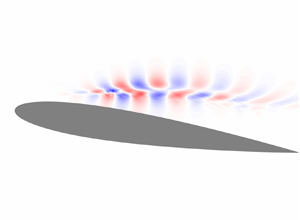Article contents
Sparsifying the resolvent forcing mode via gradient-based optimisation
Published online by Cambridge University Press: 06 July 2022
Abstract

We consider the use of sparsity-promoting norms in obtaining localised forcing structures from resolvent analysis. By formulating the optimal forcing problem as a Riemannian optimisation, we are able to maximise cost functionals whilst maintaining a unit-energy forcing. Taking the cost functional to be the energy norm of the driven response results in a traditional resolvent analysis and is solvable by a singular value decomposition (SVD). By modifying this cost functional with the  $L_1$-norm, we target spatially localised structures that provide an efficient amplification in the energy of the response. We showcase this optimisation procedure on two flows: plane Poiseuille flow at Reynolds number
$L_1$-norm, we target spatially localised structures that provide an efficient amplification in the energy of the response. We showcase this optimisation procedure on two flows: plane Poiseuille flow at Reynolds number  $Re=4000$, and turbulent flow past a NACA 0012 aerofoil at
$Re=4000$, and turbulent flow past a NACA 0012 aerofoil at  $Re=23\,000$. In both cases, the optimisation yields sparse forcing modes that maintain important features of the structures arising from an SVD in order to provide a gain in energy. These results showcase the benefits of utilising a sparsity-promoting resolvent formulation to uncover sparse forcings, specifically with a view to using them as actuation locations for flow control.
$Re=23\,000$. In both cases, the optimisation yields sparse forcing modes that maintain important features of the structures arising from an SVD in order to provide a gain in energy. These results showcase the benefits of utilising a sparsity-promoting resolvent formulation to uncover sparse forcings, specifically with a view to using them as actuation locations for flow control.
JFM classification
- Type
- JFM Papers
- Information
- Copyright
- © The Author(s), 2022. Published by Cambridge University Press
Footnotes
Present address: Department of Applied Mathematics, University of Leeds, Leeds LS2 9JT, UK.
Present address: Department of Mechanical and Aerospace Engineering, North Carolina State University, NC 27695, USA.
Present address: Physical Science and Engineering Division, King Abdullah University of Science and Technology, Thuwal 23955-6900, Kingdom of Saudi Arabia.
References
- 14
- Cited by





